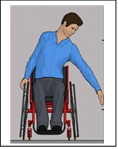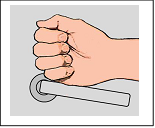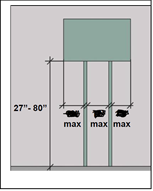| 1. |
Compliance ______________ for operable parts located in accessible spaces and along accessible routes. Operable parts include light switches, electrical and communication receptacles, thermostats, alarm pulls, automatic door controls, and other elements used by facility occupants. |
|
|
Is not required |
|
|
Is required |
| 2. |
Operable Parts Requirements apply generally to all types of operable parts covered. They are also referenced by technical sections of the standards covering drinking fountains, faucet and flush controls, ATM and fare machines, appliances, storage, windows, and door and gate hardware, and other elements. |
|
|
True |
|
|
False |
| 3. |
At most elements, clear floor space can be positioned for either a forward approach or a side approach. A forward approach ______________ at some elements, such as drinking fountains and lavatories, for easier access. |
|
|
Is not required |
|
|
Is required |
| 4. |
The range for side reach, like forward reach is 15″ to 48″ if unobstructed. The maximum reach depth for this range is _______ measured from the available clear floor space.

|
|
|
10" |
|
|
15" |
|
|
12" |
| 5. |
Operable parts must be usable with one hand and not require:
- tight grasping, pinching, or twisting of the wrist, or
- more than 5 pounds of force (lbf) to operate.

|
|
|
True |
|
|
False |
| 6. |
To prevent hazards to people with vision impairments from "Protruding Objects", the standards limit the projection of objects into circulation paths. These requirements apply to all circulation paths and are not limited to accessible routes. Circulation paths include interior and exterior walks, paths, hallways, courtyards, elevators, platform lifts, ramps, stairways, and landings. |
|
|
True |
|
|
False |
| 7. |
Side partitions or panels and wing walls can also be used to make protruding objects compliant. The bottom edge of panels or partitions must be 27” high maximum. |
|
|
27" |
|
|
35" |
|
|
42" |
| 8. |
Free-standing objects with leading edges 27" to 80" high that are mounted on posts or pylons cannot protrude more than ___ into circulation paths. The ___ limit also applies to the clearance between multiple posts (excluding the sloping portions of handrails).

|
|
|
24" |
|
|
12" |
|
|
14" |
| 9. |
Headroom clearance of at least 80" high is required along all circulation paths (except at doors and doorways where a 78" minimum clearance is permitted to accommodate door stops and closers). |
|
|
True |
|
|
False |
| 10. |
People with vision impairments often travel closely along walls which can provide wayfinding cues sometime called a "shoreline." Objects mounted on walls, partitions, columns, and other elements along circulation paths can pose hazards unless their projection is limited. Those with leading edges that are within cane sweep (27" high maximum) or that provide minimum headroom clearance (80” minimum) do not pose hazards and can protrude any amount. |
|
|
True |
|
|
False |
|